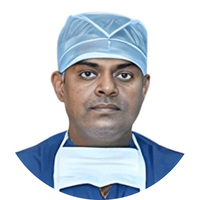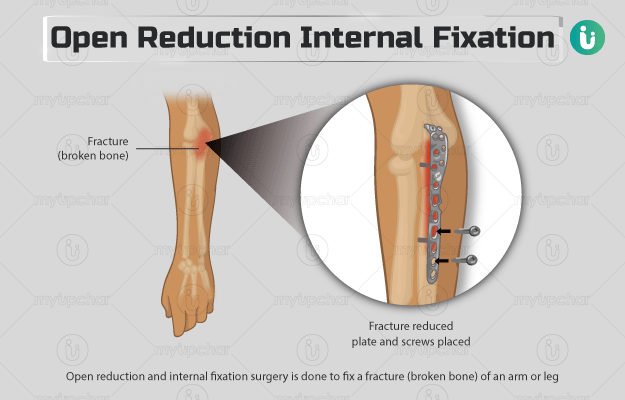Summary
Open reduction and internal fixation refer to the fixation of a broken bone in an arm or leg. This procedure can be performed in two parts or it may be done together. During the procedure, the surgeon first makes an incision to access the affected bones and align them to their positions (open reduction). This is followed by securing the bone with hardware such as plates, screws, nails or rods (internal fixation). This surgical procedure is generally performed if the fracture is severe or the bone fragments are scattered. In case of an accident, the surgeon may choose to perform this surgery immediately. If surgery is not immediately done, then you will need to fast until after the surgery. The affected limb is supported in a sling during (or sometimes after) the surgery. The surgeon may choose to conduct this procedure under the effect of general anaesthesia. You may also receive spinal anaesthesia to block the pain.
After the surgery, you must avoid moving your arm or leg for a few days. Your recovery will include physical therapy, restrictions on certain activities, proper care of the wound, and management of pain and swelling.
- What is open reduction internal fixation (ORIF)?
- Why is open reduction internal fixation recommended?
- Who can and cannot get open reduction internal fixation?
- What preparations are needed before open reduction internal fixation?
- How is open reduction internal fixation done?
- How to care for yourself after open reduction internal fixation?
- What are the possible complications/risks of open reduction internal fixation?
- When to follow up with your doctor after an open reduction internal fixation?
What is open reduction internal fixation (ORIF)?
Open reduction and internal fixation surgery is done to fix a fracture (broken bone) of an arm or leg. It comprises two main steps:
- Open reduction: In this step, an incision is made to expose/access the affected bone and to bring the bone to its original position.
- Internal fixation: The affected bone is fixed in place with special hardware such as metal screws, nails, rods, or sutures.
Fractures are usually treated with support/plaster (brace, splint or a cast to retain the bone in its natural position) and medicines to relieve pain. However, if a fracture is severe or the bone fragments have moved out of position, then the surgeon will perform an ORIF procedure to prevent the bones from healing in the wrong position. This surgery will help position your bones properly and result in better healing. In case of an accident, a surgeon may choose to perform this procedure straight away after the necessary preparations.
Why is open reduction internal fixation recommended?
A healthcare provider may perform an ORIF if you have a fracture in your arm (which includes the bones located above and beneath the elbow, wrist or elbow joint) or leg (which includes the bones located above and below the knees and ankle joint) that cannot be naturally healed. This surgery is usually performed for the following cases:
- Dislocated joint
- Multiple pieces of broken bone
- Failure to heal the bone through other treatments such as close reduction (no incision involved)
- When the bone punctures through the skin at the fracture site
- Pieces of the bone are significantly out of alignment
Who can and cannot get open reduction internal fixation?
An early (emergency) procedure may be contraindicated if you have:
- A severe wound over the cracked bone (open fracture) with soft tissue (e.g., muscle) damage.
- Gross contamination (a wound that is easily liable to infection because of the exposure to unhygienic conditions).
- Multisystem trauma (affecting more than one system of the body) and the presence of multiple diseases at once.
What preparations are needed before open reduction internal fixation?
Before undergoing this procedure, you will need the following preparations:
- Your healthcare provider will perform a complete physical examination and review your medical history. He/she will arrange for an x-ray, magnetic resonance imaging or a computed tomography scan to observe the broken bone and plan the surgery.
- Tell your doctor if you are taking any medications. This should also include over-the-counter medicines (e.g., aspirin), vitamins, supplements or natural medications.
- You must notify the medical/surgical team if you have allergies to any medications or surgical components such as tape or latex.
- Inform your doctor if you are or could be pregnant.
- You should ask someone, a close acquittance or a family member, to take you for surgery and ride you home after the procedure.
- If this surgery is not performed immediately, then you will need to fast from midnight before the surgery until you are allowed to eat/drink afterwards. This is done to reduce the complications of anaesthesia during the surgery.
- In a planned surgery, you will be asked to stop the intake of blood thinners such as aspirin for a week before this procedure. Your limb may also be supported through a sling (traction) until the duration of surgery or maybe afterwards.
- Smoking cessation and alcohol avoidance can improve your recovery after the surgery.
- Your willingness for this surgery will be established after your sign a consent form.
How is open reduction internal fixation done?
Once the admission procedure is completed, you will be asked to wear a hospital gown and lie on your back (supine) over the operating table. The medical staff will start an intravenous line in your arm to give you medicines and fluids. You will be given general anaesthesia, which will keep you relaxed and pain-free during the surgery. The anaesthetist (a doctor that administers anaesthesia) may also inject anaesthesia in your spine to block the pain and reduce pain after the surgery. Your vital functions, such as blood pressure or heart rate, will be constantly monitored throughout the surgery.
The medical staff will clean the incision area with an antiseptic solution. The surgery will then be done in the following way:
- The surgeon will cut your skin and muscles over the broken bone.
- He/she will align together the broken pieces of the bone, thereby completing the reduction process.
- Next, the surgeon will fix the bone pieces together using screws, metal plates or rod.
- He/she may also perform other repairs, including any damaged skin and muscle layer.
- Once the fixation process is complete, the surgeon or the medical team will seal the incisions using sutures or staples and apply a bandage to cover them.
- You may have to wear a cast or a splint to protect the area of surgery.
The duration of this surgery may vary based on the severity and location of the broken bone. After the surgery, you will be moved to the recovery ward/room, where your health will be monitored. For arm surgery, your stay in the hospital may not last for more than a day; however, for a leg surgery, your hospital stay may extend for several days. Before your discharge, the medical team/nurse will perform an x-ray scan of your bones to assess the repair.
How to care for yourself after open reduction internal fixation?
Once you are home after the surgery, you will require about three to 12 months for a full recovery. During this period, your routine should include the following:
- Medications:
- The surgeon may prescribe a few painkiller medications. Take them as directed.
- You will have to take blood thinners for a few days to avoid the risk of blood clots after the surgery.
- Swelling management:
- You must keep your leg or arm lifted above the chest height for at least two days to reduce the swelling after surgery.
- You can also apply ice over the area of surgery to reduce the swelling.
- Activities:
- Avoid putting unnecessary pressure or strain on the operated area.
- Avoid moving your limb for several weeks after the surgery.
- You must ensure the proper use of crutches, wheelchair or sling if advised by the doctor.
- Your doctor may advise physical therapy exercises to re-establish your strength and movement after the surgery.
- Your doctor may allow you to start with your routine a few weeks after the surgery.
- Avoid lifting heavy objects or playing sports until your bone is completely healed.
- Diet: You must consume a diet rich in calcium and vitamin D (e.g., cheese, egg yolk and soy milk) to ensure faster healing of the bones after the surgery.
- Wound care:
- Make sure to keep the area of surgery dry and clean.
- You may be allowed to shower after the surgery with a proper covering on the surgical area. However, avoid soaking as it can increase the risk of the wound opening.
- Avoid the application of lotion, cream, soap or talcum powder on and around the area of surgery.
When to see the doctor?
You should notify (call or visit) your healthcare provider as soon as possible if you experience the following symptoms after the surgery:
- High fever
- Loss of blood from the operated site
- Pain in chest
- Difficulty breathing
- Increased swelling, drainage or redness from the wound site
- Soreness over the area of surgery
- Cracks or soft spots on the plaster cast
- Long-term itching under the cast
- Unbearable pain
- Cold sensation, paleness, blue colour or swelling in the fingers and toes
- Chills
What are the possible complications/risks of open reduction internal fixation?
This surgery is known to carry the following risks:
- Muscle spasm
- Nerve damage
- Infection
- Stiffness in the operated joint
- Incomplete healing of the bone or bone misalignment
- Fat embolism (a disruption of blood supply caused by deposits of fat)
- Pain or difficulty in moving or swelling in the affected limb
- Broken screws or plates
- Instability in joints
- Reaction to anaesthesia
- Irritation to the tissues around the hardware (plate, screw, etc.)
- Blood clot
- Dislocation of the hardware placed inside the bone
When to follow up with your doctor after an open reduction internal fixation?
You will need to visit the hospital a week after the surgery to get your sutures or staples removed. Your plaster may also be changed during the initial post-operative visit. This is usually changed again after six weeks.
Disclaimer: The above information is provided purely from an educational point of view and is in no way a substitute for medical advice by a qualified doctor.
Surgery Cost In Your City
Doctors for Open reduction internal fixation

Dr. Manoj Kumar S
Orthopedics
8 Years of Experience

Dr. Ankur Saurav
Orthopedics
20 Years of Experience

Dr. Pritish Singh
Orthopedics
12 Years of Experience

Dr. Vikas Patel
Orthopedics
6 Years of Experience
References
- Intermountain Healthcare [Internet]. Utah. US; Open Reduction and Internal Fixation (ORIF)
- Johns Hopkins Medicine [Internet]. The Johns Hopkins University, The Johns Hopkins Hospital, and Johns Hopkins Health System; Ankle Fracture Open Reduction and Internal Fixation
- Ruchelsman DE, Raskin KB, Rettig ME. Fractures and injuries of the distal radius and carpus. Elsevier; 2009. Chapter 22, Galeazzi Fracture – Dislocations. p.231–239.
- Beth Israel Lahey Health: Winchester Hospital [Internet]. Winchester. Maryland. US; Open Reduction and Internal Fixation Surgery
- Oxford University Hospitals [internet]: NHS Foundation Trust. National Health Service. U.K.; Caring for surgical wounds at home















